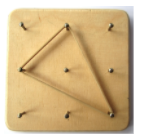
Area and Perimeter with Geoboards

Overview
Math Learning Center Geoboard is a manipulative tool students use in geometry to explore the basic concepts of polygons. It also helps with the discovery of area and perimeter. It is a board that contains a certain number of nails in which rubber bands go around to create the shape.
Learning Objectives
Students will:
- Be able to create various line segments and polygons by stretching the bands around the Geoboard pegs.
- Be able to calculate the perimeter and the area.
- Be able to write equations and expressions with the text tool.
Vocabulary
Vocabulary Words:
- Geometry: Geometry is the study of shapes.
- Geoboard: A Geoboard is a manipulative tool used in geometry to study the basic shapes.
- Area: Area is a surface measurement
- Perimeter: Perimeter is the boundary of a closed geometric figure.
- Polygon: A polygon is a plane figure with at least three straight sides and angles.
Pre-planning
To prepare for this lesson:
- Students should be familiar with geometry terms.
- The teacher should introduce the students to the Math Learning Center and the tools to use the Geoboard. View the videos below for assistance.
Accommodations
See Accommodations Page and Charts on the 21things4students.net site in the Teacher Resources.
Steps
Directions for this activity:
- Have students log onto the Math Learning Center.
- Open Web App (or application appropriate for device).
- Use rubber bands to create polygons.
- Use tools to calculate the area and perimeter.
- Drawing tool to label the sides.
- Calculator to calculate the area if needed.
Assessment Options
Different options for assessing the students:
- Observations
- Check for understanding
- Assess students with prepared polygons to find the area and perimeter.
- Students demonstrate their model on the projector for the class.
- Math talks discussing how to calculate area and perimeter.
- Give the students a given shape and have them calculate the area and/or perimeter, name of a polygon on an exit ticket.
MITECS COMPETENCIES & ISTE STANDARDS
MITECS: Michigan adopted the "ISTE Standards for Students" called MITECS (Michigan Integrated Technology Competencies for Students) in 2018.
Empowered Learning
1a. Students articulate and set personal learning goals, develop strategies leveraging technology to achieve them and reflect on the learning process itself to improve learning outcomes.
1b. Students build networks and customize their learning environments in ways that support the learning process.
1c. Students use technology to seek feedback that informs and improves their practice and to demonstrate their learning in a variety of ways.
1d. Students understand the fundamental concepts of technology operations, demonstrate the ability to choose, use and troubleshoot current technologies and are able to transfer their knowledge
Computational Thinking
5a. Students formulate problem definitions suited for technology assisted methods such as data analysis, abstract models and algorithmic thinking in exploring and finding solutions.
5c. Students break problems into component parts, extract key information, and develop descriptive models to understand complex systems or facilitate problem-solving.
5d. Students understand how automation works and use algorithmic thinking to develop a sequence of steps to create and test automated solutions.
Devices and Resources
Device: PC, Chromebook, Mac, iPad
Browser: Chrome, Safari, Firefox, Edge, ALL
Apps. Extensions, Add-ons
Websites:
Geoboards Video
CONTENT AREA RESOURCES
ELA
Students write about how to use a Geoboard and solve for area and perimeter, they describe polygons.
Integrated Arts
Students draw diagrams of a Geoboard
Math
Have math talks with the students about area and perimeter, and different polygon shapes.
Social Studies
Credits
This task card was created by Julie Hoehing, Lake Shore Public Schools, June 2020.


